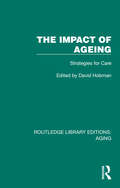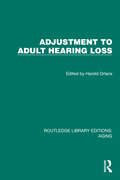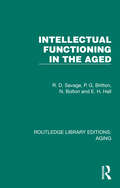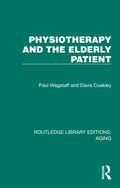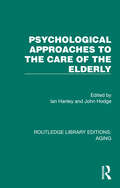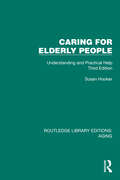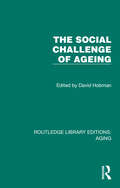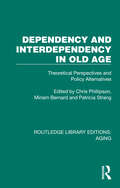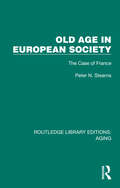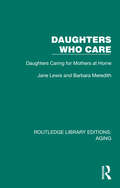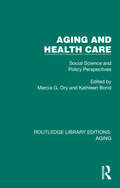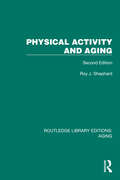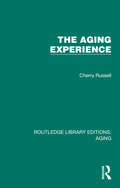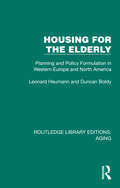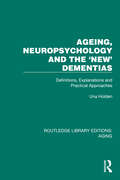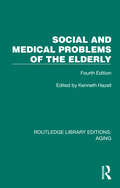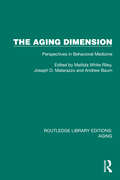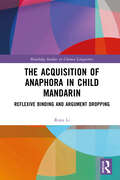- Table View
- List View
The Impact of Ageing: Strategies for Care (Routledge Library Editions: Aging)
by David HobmanAt the beginning of the 1980s, the previous few decades had been characterised by a ‘population explosion’ amongst the older age groups. Due to the success of medical science at prolonging life, this phenomenon had been experienced throughout both the developing and the developed world. Given the acute economic difficulties faced by the countries concerned, it was apparent that the allocation of resources, in terms of cash and care, would have to concentrate on the oldest and frailest members of the community.Originally published in 1981, this book presented an important contribution toward the necessity for a multidisciplinary, international approach to both public policy-making and practice at the time. The continued social functioning of the ageing community as a whole was dependent upon a combination of social and health care services together with adequate income maintenance provision, suitable housing and transport services to enable the majority to function as autonomous individuals.Drawing on experience from many countries, this unique volume brings together the extensive knowledge of practitioners in politics, social administration and care services with scholars who were now beginning to recognise the importance of ageing as a key issue upon which the social well-being of society as a whole depends.
Adjustment to Adult Hearing Loss (Routledge Library Editions: Aging)
by Harold OrlansOriginally published in 1985, the chapters in this book were, with two exceptions, first prepared for and discussed at a monthly research seminar series on Hearing Loss in Adulthood during the 1983-1984 academic year. One of the exceptions was included to fill a major gap in the literature dealing with the experience of persons who suffer a moderate hearing loss in midlife. The other, by the editor, presents his observations and reiterates significant points made by a number of seminar members. As a whole this book shines a light on the experience of hearing-impaired people, particularly the loss of hearing in later life.
Intellectual Functioning in the Aged (Routledge Library Editions: Aging)
by R. D. Savage P. G. Britton N. Bolton E.H. HallBy the early 1970s the psychology of age had become an extremely important topic in the field. In the present book, originally published in 1973, the authors are particularly concerned with the subject of intellectual functioning. The assessment of intellect in the aged has many important theoretical and practical implications. At the same time, this work was of vital importance to the problems of medical illness in the aged, particularly with psychiatric and neurological diagnosis. Intellectual functioning is severely affected by psychiatric illness – but the intellectual difficulties associated with functional disorder in the aged may be quite different from those in the young. The cross-fertilization of psychiatric and psychological work on problems of the aged at the time left much to be desired. It was the hope of the present book to contribute towards a much firmer amalgamation of the two attitudes.The book would have been of general interest to psychologists interested in cognitive assessment, to those concerned with the developmental aspects of intellectual functioning and also to clinical psychologists and social welfare workers with particular responsibility for the aged. Today it can be read in its historical context.
Physiotherapy and the Elderly Patient (Routledge Library Editions: Aging)
by Paul Wagstaff Davis CoakleyOriginally published in 1988, the purpose of this book was to introduce the student and practicing physiotherapist to the multi-faceted components of the care and treatment of elderly patients and to present a problem-orientated approach to physiotherapy, assessment and management. Care of the elderly demands a dynamic and responsible approach and it was hoped that this book would improve therapy skills. The authors’ principle aim was to describe appropriate physiotherapy practice together with the pathology and medicine of old age. There is also consideration of social and psychological issues and working with the elderly people in the community as well as in hospital.
The Impact of Ageing: Strategies for Care (Routledge Library Editions: Aging)
by David HobmanAt the beginning of the 1980s, the previous few decades had been characterised by a ‘population explosion’ amongst the older age groups. Due to the success of medical science at prolonging life, this phenomenon had been experienced throughout both the developing and the developed world. Given the acute economic difficulties faced by the countries concerned, it was apparent that the allocation of resources, in terms of cash and care, would have to concentrate on the oldest and frailest members of the community.Originally published in 1981, this book presented an important contribution toward the necessity for a multidisciplinary, international approach to both public policy-making and practice at the time. The continued social functioning of the ageing community as a whole was dependent upon a combination of social and health care services together with adequate income maintenance provision, suitable housing and transport services to enable the majority to function as autonomous individuals.Drawing on experience from many countries, this unique volume brings together the extensive knowledge of practitioners in politics, social administration and care services with scholars who were now beginning to recognise the importance of ageing as a key issue upon which the social well-being of society as a whole depends.
Psychological Approaches to the Care of the Elderly (Routledge Library Editions: Aging)
by Ian Hanley John HodgeOriginally published in 1984, the overall purpose of this book was to provide ideas and suggestions about the usefulness of applied psychology in dealing with some of the problems of the elderly.Although many problems of the elderly are not included, the editors wanted to put forward ideas which they, both individually and collectively, had found to be of practical value in dealing with the kinds of problem they found to be most urgent. Despite the recent increase of interest by psychologists in this field, many professional and non-professional workers had not had any experience in working alongside a psychologist. In addition, there were many professional psychologists who had had little to do with this specialist field. The book was aimed at these two groups.The chapters of this book range from the more traditional psychological topic of assessment through to psychological treatment and management approaches for various problems.
Caring for Elderly People: Understanding and Practical Help (Third Edition) (Routledge Library Editions: Aging)
by Susan HookerFirst published in 1976, Caring for Elderly People rapidly established itself as a standard guide for anyone dealing on a day-to-day basis with the elderly. This updated and revised edition, originally published in 1990, contains information on financial help and services and on the new technology available at the time.The book concerns itself primarily with elderly people who are either living alone or with relatives. In addition to setting out the practical steps to be taken in the treatment of illness (such as Parkinson’s disease, stroke, bronchitis, etc.), the author explains why elderly people cannot cope with apparently simple operations, and why they act in a certain way. An extensive list of aids and gadgets, ancillary and community services, is designed to provide supportive advice to relatives and professionals alike, and to encourage the maximum possible self-reliance in the elderly.
The Social Challenge of Ageing (Routledge Library Editions: Aging)
by David HobmanAlthough all recorded societies have contained a few people of extreme old age, they have been the exception rather than the rule. The possibility of one fifth of the total population in retirement from active employment would have been unthinkable at the beginning of the twentieth century and even social planning in the 1970s had made no adequate provision for a society in which one in every twenty-five people would be over seventy-five and one in every hundred over eighty-five within less than a decade.In Great Britain in the 1970s, however, and in many industrialised societies, this was now a reality and vast resources would need to be directed towards the support, care and treatment of the aged. Whilst a growing body of knowledge, based upon biological and clinical studies of the ageing process, had been accumulated in recent years, only a modest investment had been made in social gerontology.Originally published in 1978, this book provided a multi-disciplinary study of the process of ageing for those in the caring professions as well as for planners and architects, whose decisions and designs affected the lives of the elderly. It is divided into three parts: the first provides a sociological, demographic and cultural background to the place of old people in eastern and western societies. The second explores the relationship which exists (or should exist) between a number of professional disciplines and part three considers an interdisciplinary model in practice. Today it can be read in its historical context.
Dependency and Interdependency in Old Age: Theoretical Perspectives and Policy Alternatives (Routledge Library Editions: Aging)
by Chris Phillipson Miriam Bernard Patricia StrangOriginally published in 1986, Dependency and Interdependency in Old Age presents papers from the British Society of Gerontology annual conference in 1985. The areas covered include: the sociology of ageing, methodological issues, evaluations of service provision, ethnographies of growing old, historical studies and political perspectives on ageing. A creative dialogue between the proponents of these themes was urgently needed at the time and it was hoped that this volume would stimulate such a discussion.
Old Age in European Society: The Case of France (Routledge Library Editions: Aging)
by Peter N. StearnsOriginally published in 1977, Old Age in European Society provides an historical perspective on aging, a process which had received little attention from any group in the social sciences and virtually none from historians at the time. Starting from the premise that ‘the elderly can and should be active, participant members of their society’ the book examines the ways in which old people were and are viewed by certain key groups. This is done in a series of thematic essays linked by the main theme of a dominant culture in which the elderly and the groups who deal with them were and still are ensnared. This dominant culture is one of denigration of the elderly: the traditional idea of veneration of the elderly is found to be largely mythical. Variations on this theme are dealt with in individual chapters concerned with the elderly in French working-class culture and geriatric medicine. Key groups are studied with an eye to distinct patterns of modernization, which involves particular attention to the working class and middle class as those exposed to the leading edge of change. Women are treated separately, as their aging process involves distinctive elements, which exacerbate the problems of old age. France, with its exceptional percentage of elderly and its low retirement ages, provides much of the material for these essays, the main purpose of which is to indicate those topics for which an historical treatment is vital to our understanding of the elderly and to the formulation of a more positive approach to old age.
The Social Challenge of Ageing (Routledge Library Editions: Aging)
by David HobmanAlthough all recorded societies have contained a few people of extreme old age, they have been the exception rather than the rule. The possibility of one fifth of the total population in retirement from active employment would have been unthinkable at the beginning of the twentieth century and even social planning in the 1970s had made no adequate provision for a society in which one in every twenty-five people would be over seventy-five and one in every hundred over eighty-five within less than a decade.In Great Britain in the 1970s, however, and in many industrialised societies, this was now a reality and vast resources would need to be directed towards the support, care and treatment of the aged. Whilst a growing body of knowledge, based upon biological and clinical studies of the ageing process, had been accumulated in recent years, only a modest investment had been made in social gerontology.Originally published in 1978, this book provided a multi-disciplinary study of the process of ageing for those in the caring professions as well as for planners and architects, whose decisions and designs affected the lives of the elderly. It is divided into three parts: the first provides a sociological, demographic and cultural background to the place of old people in eastern and western societies. The second explores the relationship which exists (or should exist) between a number of professional disciplines and part three considers an interdisciplinary model in practice. Today it can be read in its historical context.
Daughters Who Care: Daughters Caring for Mothers at Home (Routledge Library Editions: Aging)
by Jane Lewis Barbara MeredithIn the 1980s, as the proportion of elderly people in the population grew steadily larger, the task of looking after them would fall increasingly on one group – daughters. The government, in promoting its move in social policy towards community care, had stated that ‘the family’ – which in practice meant women – must expect to provide the bulk of care in the future. But how do women feel about this? What impact does caring for others have on their own lives? How might professional helpers better support them?Originally published in 1988, from in-depth interviews with daughters who have looked after their mothers for varying numbers of years, Jane Lewis and Barbara Meredith look at why it is that women come to care, and consider the legacy of their caring experiences. Because caring is usually a labour of love, the feelings that surround it are complicated and fraught with ambivalence. In analysing these Daughters Who Care explores the meaning of caring from the carer’s point of view, as well as examining the implications for professionals seeking to ‘support the supporters’.Carers themselves and those working with them professionally or as volunteers, as well as students of community care, social policies for the elderly, and social psychology will all find this a stimulating approach to what is still an increasingly urgent issue.
Aging and Health Care: Social Science and Policy Perspectives (Routledge Library Editions: Aging)
by Marcia G. Ory Kathleen BondOf all the problems associated with a rapidly growing aging population, health care demands top priority. Research on health care for older people requires an understanding of the basic principles of aging and its related social processes, while popular assumptions on the subject are often ill-informed and are based more on misconceptions about aging than on scientific knowledge.Originally published in 1989, Aging and Health Care focuses on the most urgent health care problems of older people at the time and explores possible solutions. Drawing on up-to-date social and behavioral research, it provides a sound basis on which to build practices and policies on aging and health care. The contributors examine the complex relationships among aging persons, their health care needs, and the current health care and support systems. Individual chapters contribute in particular to our understanding of the interactions of the health care system with individual aging processes, and the interdependence between the informal and formal care systems.With its emphasis on the interrelationships of health care with the biological, psychological and social changes that people experience as they grow older, Aging and Health Care will still be of historical interest to those studying in social science, aging, and public health.
Physical Activity and Aging: Second Edition (Routledge Library Editions: Aging)
by Roy ShephardIn the late 1980s, the relationship between physical activity or exercise and aging was one of great contemporary interest. On the one hand there was a growing elderly population in industrialized societies seeking an active rather than a passive retirement, while on the other hand there was much current interest in the benefits to health of physical activity. The first edition of this book, published in 1978, was acknowledged as a major review of the field. In the years since its publication, however, there were many advances in our knowledge, made evident by the fact that this second edition, originally published in 1987, contains over 50 percent more references, 1840 in total. The author shows how far we can improve our adaptation to the aging process through an increase in personal fitness. Aimed at gerontologists, physicians in geriatric medicine and sports medicine, as well as other interested in human performance (for example, the physiologist, physical educator, ergonomist and physiotherapist), the book would remain a standard reference work on this subject for many years.
Caring for Elderly People: Understanding and Practical Help (Third Edition) (Routledge Library Editions: Aging)
by Susan HookerFirst published in 1976, Caring for Elderly People rapidly established itself as a standard guide for anyone dealing on a day-to-day basis with the elderly. This updated and revised edition, originally published in 1990, contains information on financial help and services and on the new technology available at the time.The book concerns itself primarily with elderly people who are either living alone or with relatives. In addition to setting out the practical steps to be taken in the treatment of illness (such as Parkinson’s disease, stroke, bronchitis, etc.), the author explains why elderly people cannot cope with apparently simple operations, and why they act in a certain way. An extensive list of aids and gadgets, ancillary and community services, is designed to provide supportive advice to relatives and professionals alike, and to encourage the maximum possible self-reliance in the elderly.
The Aging Experience (Routledge Library Editions: Aging)
by Cherry RussellLocal writing on the subject of old age had tended to a fairly uniform approach, focusing on empirical studies of old age as a social problem using census and survey-type data. Little attention had been paid to theory development. Originally published in 1981, this book provides an in-depth study of how old age was experienced in contemporary Australian society at the time. It was the first major piece of original research on aging to be published in Australia and in several important senses represented a clear departure from the mainstream of Australian gerontology. The Aging Experience links original in-depth data to a broad theoretical framework. Working from the premise that old age is a devalued status it examines the implications of this for the personal experience and interpersonal relations of elderly people. Through detailed case studies of elderly Australians their interaction with family, age peers and welfare services are described. The analysis concentrates less on the overt characteristics of these relationships and their material functions than on their symbolic content and meaning for the participants. Thus, the study moves beyond conventional statistical documentation of the problems of old age to a sharper delineation of aging as a lived experience. It is an approach which offers new perspectives, and challenges many of the assumptions underlying previous research.
Physical Activity and Aging: Second Edition (Routledge Library Editions: Aging)
by Roy ShephardIn the late 1980s, the relationship between physical activity or exercise and aging was one of great contemporary interest. On the one hand there was a growing elderly population in industrialized societies seeking an active rather than a passive retirement, while on the other hand there was much current interest in the benefits to health of physical activity. The first edition of this book, published in 1978, was acknowledged as a major review of the field. In the years since its publication, however, there were many advances in our knowledge, made evident by the fact that this second edition, originally published in 1987, contains over 50 percent more references, 1840 in total. The author shows how far we can improve our adaptation to the aging process through an increase in personal fitness. Aimed at gerontologists, physicians in geriatric medicine and sports medicine, as well as other interested in human performance (for example, the physiologist, physical educator, ergonomist and physiotherapist), the book would remain a standard reference work on this subject for many years.
Daughters Who Care: Daughters Caring for Mothers at Home (Routledge Library Editions: Aging)
by Jane Lewis Barbara MeredithIn the 1980s, as the proportion of elderly people in the population grew steadily larger, the task of looking after them would fall increasingly on one group – daughters. The government, in promoting its move in social policy towards community care, had stated that ‘the family’ – which in practice meant women – must expect to provide the bulk of care in the future. But how do women feel about this? What impact does caring for others have on their own lives? How might professional helpers better support them?Originally published in 1988, from in-depth interviews with daughters who have looked after their mothers for varying numbers of years, Jane Lewis and Barbara Meredith look at why it is that women come to care, and consider the legacy of their caring experiences. Because caring is usually a labour of love, the feelings that surround it are complicated and fraught with ambivalence. In analysing these Daughters Who Care explores the meaning of caring from the carer’s point of view, as well as examining the implications for professionals seeking to ‘support the supporters’.Carers themselves and those working with them professionally or as volunteers, as well as students of community care, social policies for the elderly, and social psychology will all find this a stimulating approach to what is still an increasingly urgent issue.
Housing for the Elderly: Planning and Policy Formulation in Western Europe and North America (Routledge Library Editions: Aging)
by Leonard Heumann Duncan BoldyDuring the 1970s housing and social welfare policy as it affected the elderly was changing throughout Western society. Conventional high-rise apartments and institutionalized nursing or residential homes were no longer the sole public responses to housing the elderly. In place of these two extremes on the housing continuum was a variety of intermediate supportive systems that aided independent living. Assisted Independent Living (AIL) programmes were designed to keep the elderly in as independent a living environment as possible despite increasing functioning disabilities and frailties that often accompany advancing age.Originally published in 1982, this book defines sheltered housing, traces its development in Western society and analyses its success under several variations in Great Britain. The British analysis focuses on those aspects of the sheltered housing programme that had wider relevance to the development of AIL housing policy in Europe and North America.
Ageing, Neuropsychology and the 'New' Dementias: Definitions, Explanations and Practical Approaches (Routledge Library Editions: Aging)
by Una HoldenUp to the 1990s, the influence of brain function disturbances and causes of dementia in the elderly had mostly been overlooked as a possible explanation for antisocial or unusual behaviour. As a result, these had tended not to be included in assessment and training programmes.Originally published in 1995, Ageing, Neuropsychology and the ‘New’ Dementias introduces the concepts of neuropsychology and behaviour and the recent research on dementia to equip the professional user with the most up-to-date knowledge of these influences on ageing. This practical resource fills the gaps in knowledge and practice by providing a wealth of explanations, suggestions for assessments and approaches to common problems encountered with this age group. Chapters focus on such issues as: recognizing the problems of head injuries, misinterpreted behaviour and impairments to brain function; re-examining the concept of dementia; management, rehabilitation and training; community care.This text would be invaluable to nurses, occupational therapists, physiotherapists, psychologists and other health professionals working with the elderly.
Social and Medical Problems of the Elderly: Fourth Edition (Routledge Library Editions: Aging)
by Kenneth HazellIn the 1960s and 1970s doctors were increasingly trained to apply science to the eradication of disease, the accent being on the treatment of disease rather than the true welfare of the patient. This is not the same as dealing with illness and its attendant problems.Originally published in 1976, this book highlights the modern approach to the care of the elderly at the time, and emphasises the individual contributions of doctor, nurse, social worker and paramedical members of the team. It also stresses the important role of voluntary associations relatives and neighbours.Much of the book is concerned with the particular medical problems which occur in the elderly and would have been of great help to the physician practising geriatric medicine at the time.This new fourth edition of the standard textbook had been fully revised and includes additional chapters on such important and practical matters as Pensionable Retirement, Housing, Home Help Services and the scope of the Hospital Advisory Service.
The Aging Dimension: Perspectives in Behavioral Medicine (Routledge Library Editions: Aging)
by Matilda White Riley Joseph D. Matarazzo Andrew BaumOriginally published in 1987, this volume, and the working conference that preceded it, broke new ground in addressing the complex topic of aging, health, and behavior. Taking a bio-behavioral approach to a range of topics, contributors to this book advanced their disciplines. This volume as well as searching for important interfaces between behavior and health also added the dynamic aspect of aging. Cells, organ systems, and whole human beings all change as they move through life, linking health in varied and intricate ways to changes in behavior patterns, social structures, and cultural values and norms.
Aging and Health Care: Social Science and Policy Perspectives (Routledge Library Editions: Aging)
by Marcia G. Ory Kathleen BondOf all the problems associated with a rapidly growing aging population, health care demands top priority. Research on health care for older people requires an understanding of the basic principles of aging and its related social processes, while popular assumptions on the subject are often ill-informed and are based more on misconceptions about aging than on scientific knowledge.Originally published in 1989, Aging and Health Care focuses on the most urgent health care problems of older people at the time and explores possible solutions. Drawing on up-to-date social and behavioral research, it provides a sound basis on which to build practices and policies on aging and health care. The contributors examine the complex relationships among aging persons, their health care needs, and the current health care and support systems. Individual chapters contribute in particular to our understanding of the interactions of the health care system with individual aging processes, and the interdependence between the informal and formal care systems.With its emphasis on the interrelationships of health care with the biological, psychological and social changes that people experience as they grow older, Aging and Health Care will still be of historical interest to those studying in social science, aging, and public health.
The Acquisition of Anaphora in Child Mandarin: Reflexive Binding and Argument Dropping (Routledge Studies in Chinese Linguistics)
by Ruya LiThe Acquisition of Anaphora in Child Mandarin explores how Mandarin-speaking children’s interpretation of the reflexive ziji and their use of null arguments can be understood under the notions of locality and prominence.This book investigates the interpretation of ziji and the use of null subjects and null objects by experimenting on Mandarin-speaking children and adults using a range of experimental techniques such as the truth value judgment task, the picture identification task, and the story-telling task.The book provides evidence to show that reflexive binding and argument dropping are determined by the interplay between universal principles and language-specific properties. It shows that children at the age of 4 make an adult-like distinction between the anaphoric and logophoric interpretations of ziji. The former is subject to the locality condition manifested by the blocking effect on the long-distance binding of ziji, whereas the latter is free from the locality condition and closely related to the understanding of the false beliefs of others.This book is an important contribution to language acquisition research and can serve as a valuable reference for graduate students and researchers in the field of language acquisition, Chinese linguistics, psycholinguistics, and cognitive science.
The Acquisition of Anaphora in Child Mandarin: Reflexive Binding and Argument Dropping (Routledge Studies in Chinese Linguistics)
by Ruya LiThe Acquisition of Anaphora in Child Mandarin explores how Mandarin-speaking children’s interpretation of the reflexive ziji and their use of null arguments can be understood under the notions of locality and prominence.This book investigates the interpretation of ziji and the use of null subjects and null objects by experimenting on Mandarin-speaking children and adults using a range of experimental techniques such as the truth value judgment task, the picture identification task, and the story-telling task.The book provides evidence to show that reflexive binding and argument dropping are determined by the interplay between universal principles and language-specific properties. It shows that children at the age of 4 make an adult-like distinction between the anaphoric and logophoric interpretations of ziji. The former is subject to the locality condition manifested by the blocking effect on the long-distance binding of ziji, whereas the latter is free from the locality condition and closely related to the understanding of the false beliefs of others.This book is an important contribution to language acquisition research and can serve as a valuable reference for graduate students and researchers in the field of language acquisition, Chinese linguistics, psycholinguistics, and cognitive science.
